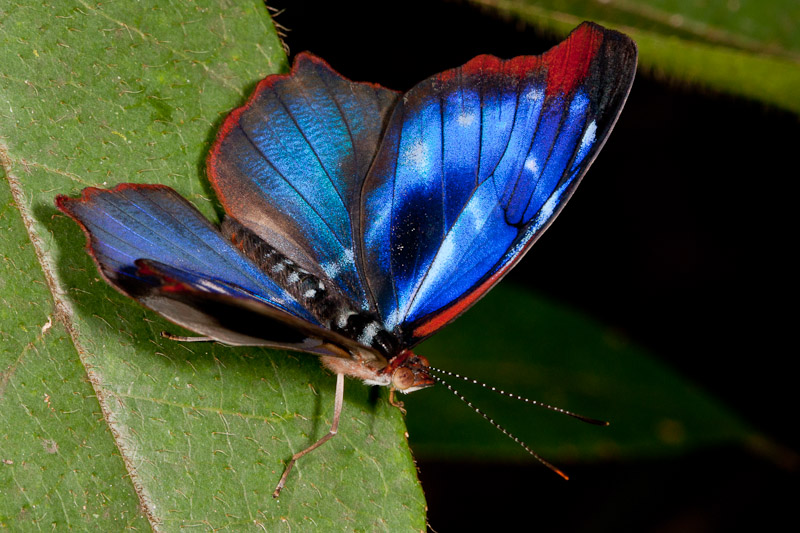The plant and animal kingdoms abound with bright colors, from the lush green of photosynthesizing plants to the striking colors of fluttering butterflies. Colors signal the harvest time, breeding conditions, and the change of seasons. Animals can also use their colors to camouflage, or to warn other creatures.
Pigments are chemical compounds that are responsible for many of the beautiful colors we see in the plant and animal worlds. Pigments absorb some of the light they receive, and reflect only certain wavelengths of visible light; color arises from the way the pigments react with light.
Fabulous Fauna
The most common animal pigment is melanin, which is a brown or black polymer that occurs in skin or fur. Melanin absorbs most color wavelengths and therefore appears very dark to the eye; it produces a huge color range, from black, to sandy, to red.
The diversity of bird feathers’ colors can be explained by just two factors: pigments and simple structures in the feathers that interfere with incident light. Pigment particles are embedded into the newly-grown feathers during the molting season. They absorb light of certain wavelengths, or disperse the reflected light, and so contribute to the color of the plumage.
While animals produce melanin, they are unable to make any other type of pigments; several animals, however, are colored by what they ingest.
Fancy Flamingos
Actually, flamingos are not pink; they are born with grey feathers, which gradually turn pink or reddish in color because of a natural dye they obtain from their diet. This dye comes from carotenoid proteins in their diet of animal and plant plankton, such as brine shrimp and blue-green algae. Liver enzymes break down these proteins into pink pigment molecules deposited in the feathers, bill, and legs of the flamingos.
The source of the dye varies by species, and affects the saturation of color. Flamingos, the sole diet of which is blue-green algae, are darker in color compared to those which obtain it from animals that have digested blue-green algae, such as brine shrimps. Brine shrimps are also unable to make their own carotenoids; the tiny shrimp, however, eats microscopic algae that manufacture red and yellow pigments, so when the flamingos feed on these shrimps they acquire the pink color eventually.
In order to keep zoo flamingos pink, zoo keepers feed them a special diet that includes prawns, or mix another chemical such as beta-carotene or canthaxanthin into their food; otherwise they would be white, grey, or pale pink.

Bright Butterflies
Butterflies are among the most colorful and beautiful insects; they possess some of the most striking color displays found in nature. The coloration of butterfly wings serves a number of purposes, including camouflage, warning to predators, attracting a mate, deception, and heat collection. Moreover, there are ultraviolet patterns in butterfly wings that can be seen by other butterflies, but not human.
Most butterflies get their different shades of brown and yellow from melanin. The structural color of butterflies stems from the specific structure of the butterflies’ wings, which explains why some butterfly colors seem to shift and appear so intense. Every time the observer moves, some butterflies appear to have different colors; this quality is known as iridescence, which happens when light passes through a transparent, multilayered surface, and is reflected more than once. The multiple reflections compound one another and intensify colors.
Butterfly wings amplify the effects of iridescence because they have many layers for the light to pass through, and thus many more opportunities for the light waves to reflect and magnify one another. Even though they are small, butterfly wings are covered by thousands of microscopic scales, split into two to three layers; in turn, each scale has multiple layers separated by air.
Iridescence is due to multiple-slit interference, which occurs when light hitting the wing interacts with light reflected off the wing; the combination of these reflections causes the intense colors seen in the butterfly.
The combination of a butterfly’s structural and pigmented color can create interesting effects. For example, if you saw a butterfly with yellow pigment underneath a structure that creates a blue iridescent color, you might see a green shade, made by merging of the two colors. The colors would change as the butterfly flaps its wings, and the light enters through different angles.

*Published in PSC Newsletter, 2nd School Semester 2012/2013 issue.
References
webexhibits.org
hotword.dictionary.com
britannica.com
oceans.taraexpeditions.org
dailymail.co.uk
ehow.com
earthweek.com
incrediblethings.com
blog.lib.umn.edu
lifeslittlemysteries.com
whyzz.com
hiltonpond.org
sciencefocus.com